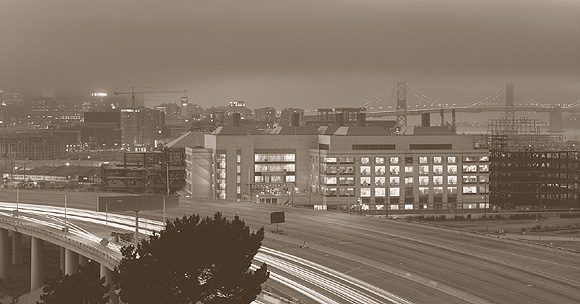
In the fall of 2005, the ten campuses of the University of California served 208,336 students, taught by 14,231 full-time-equivalent faculty members and supported by more than 150,000 staff (by headcount). Collectively, the campuses occupy roughly 20,000 acres of land. The University’s operating budget for 2005-06 is over $15 billion.
In this issue of arcCA, we look at current issues on the UC campuses, admittedly merely scratching the surface. Our survey is neither exhaustive nor symmetrical, but it is safe to say that the issues touched upon for any one campus apply in some way to all of them: the question of project delivery methods being explored at UC San Diego, the relation between iconic buildings and campus unity at UC Irvine, or the pressures of densification at UCLA. (Have you noticed that no one ever says, “UC Los Angeles”?)
UC Santa Barbara has set its sights on bringing a coherent order to a campus that displays the divergent architectural and planning attitudes of the post-war decades. The goal of UC Berkeley’s Landscape Heritage Plan carries the question of campus unity back through three historical periods—the Picturesque era of the third quarter of the nineteenth century, turn-of-the-century Beaux Arts Classicism, and mid-twentieth century Modernism—while trying, at the same time, to leave open a window onto the future.
UC Santa Cruz, despite its discreet siting in the wooded hills above the City of Santa Cruz, struggles with its relationship to the town. UC San Francisco brings the question posed at Irvine—the relation between iconic buildings and the campus fabric—to bear on a brand new campus in the midst of, yet in many ways isolated from, its self-consciously historical host city. UC Riverside is rising to the challenge, set by the University’s Board of Regents, to make all new university buildings LEED-equivalent. UC Davis seeks to balance the necessity for growth with a respect for the agricultural lands that surround it. And, finally, UC Merced, the newest campus, finds itself in the spotlight of unparalleled population growth projected for the Central Valley.
Sustainable growth, town-gown relations, campus identity, progress with respect for history: these are among the common concerns of the University of California campuses outlined here. We supplement the individual campus reports with a color section illustrating some of the best of recent campus construction. I hope that this taste of what’s happening will encourage you to explore the campus nearest you and to browse the virtual world of the UC websites, to learn more about this vital sector of the building enterprise in California.
And let me assure you that, while our resources of space and time have severely limited the depth of our exploration, we have been scrupulously even-handed.
Go Bears.

Author Tim Culvahouse, FAIA, is the editor of arcCA.
Originally published 4th quarter 2006 in arcCA 06.4, “The UCs.”





